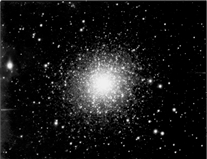M013_DSI2PRO_09C_CLEAR_13x300sec_ip-adpadd.jpg
M013_DSI2PRO+09C_CLEAR_13x300sec_ip-adpadd.jpg
Enter image description for image (M013_DSI2PRO+09C_CLEAR_13x300sec_ip-adpadd.jpg)
M13 taken with DSI2 and 10" f/10 Meade classic OTA on AP1200 mount. 9C sensor temp on DSI 2 Pro
13x5min exposures.
Note small galaxy at the top.
M13 is call the Hercules Cluster because it is in the constellation Hercules. It is very large and it can be seen with binoculars as a fuzzy object.
Messier 13
Globular Cluster M13 (NGC 6205), class V, in Hercules
Hercules Globular Cluster
Right Ascension 16 : 41.7 (h:m)
Declination +36 : 28 (deg:m)
Distance 25.1 (kly)
Visual Brightness 5.8 (mag)
Apparent Dimension 20.0 (arc min)
Discovered by Edmond Halley in 1714.
Excerpt from seds.org:
Messier 13 (M13, NGC 6205), also called the 'Great globular cluster in Hercules', is one of the most prominent and best known globulars of the Northern celestial hemisphere.
It was discovered by Edmond Halley in 1714, who noted that 'it shows itself to the naked eye when the sky is serene and the Moon absent.' According to Charles Messier, who cataloged it on June 1, 1764, it is also reported in John Bevis' "English" Celestial Atlas.
At its distance of 25,100 light years, its angular diameter of 20' corresponds to a linear 145 light years - visually, it is perhaps 13' large. It contains several 100,000 stars; Timothy Ferris in his book Galaxies even says "more than a million". Towards its center, stars are about 500 times more concentrated than in the solar neighborhood. The age of M13 has been determined by Sandage as 24 billion years and by Arp as 17 billion years around 1960; Arp later (in 1962) revised his value to 14 billion years (taken from Kenneth Glyn Jones).
According to Kenneth Glyn Jones, M13 is peculiar in containing one young blue star, Barnard No. 29, of spectral type B2. The membership of this star was confirmed by radial velocity measurement, and is strange for such an old cluster - apparently it is a captured field star.
Observers note 4 apparently star-poor regions in M13 (e.g., Mallas). Suggestions of them can be noted in some photos.
Globular cluster M13 was selected in 1974 as target for one of the first radio messages addressed to possible extra-terrestrial intelligent races, and sent by the big radio telescope of the Arecibo Observatory.
Nearby, about 40 arc minutes north-east of M13, is the faint (mag 11) galaxy NGC 6207, visible in many large- and medium-size-field photographs of M13, e.g., in the DSSM image. This galaxy has recently produced a type II supernova (SN 2004A).
